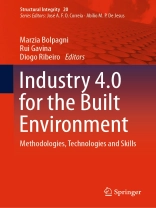This book discusses how the role of traditional construction professional is changing, providing a useful guide for practitioners who would like to upskill themselves. Lately, core concepts and methodologies for the Built Environment are presented providing definitions and applications on Building Information Modelling, Computational Design, Artificial Intelligence, Big Data, Cloud Computing, Data Analytics and Visualization, Lean Construction, Advanced Project Management, Sustainability, Geographical Information Systems, Advanced Business Models, Disaster Management, Quality Management, Health and Safety and Legal prospective. The book also shows the latest technologies for the Built Environment including Digital Twins, Reality Capture, Extended Reality, Gamification, Computational Construction and Manufacturing, Structural Health Monitoring, Smart Transaction and Cybersecurity. Trends in soft skills for the Built Environment are presented covering Digital Working, Communication, Self and Relationship Management skills and Critical thinking. The book is dedicated to professionals who would like to enhance their understanding and capabilities to operate in the Industry 4.0 for the Built Environment having a holistic and comprehensive overview.
Spis treści
Chapter 1. Shaping the Future of Construction Professionals (Marzia Bolpagni).- Part I. Concepts and Methodologies for the Built Environment.- Chapter 2. Building Information Modelling and Information Management (Marzia Bolpagni).- Chapter 3. Introduction to Computational Design: Subsets, Challenges in Practice and Emerging Roles (Aurelie de Boissieu).- Chapter 4. Advanced Applications in Computational Design (Peter Debney).- Chapter 5. Artificial Intelligence for the Built Environment (Sherif Tarabishy).- Chapter 6. Big Data and Cloud Computing for the Built Environment (Marcin Kosicki).- Chapter 7. Knowledge Graphs and Linked Data for the Built Environment (Pieter Pauwels).- Chapter 8. Information Visualisation for the Construction Industry (Michele Mauri).- Chapter 9. The Role of Lean in Digital Construction (Kevin Mc Hugh).- Chapter 10. Non-linear project management: Agile, Scrum and Kanban for the Construction Industry (Mohammad Saki).- Chapter 11. Achieving Sustainability in Construction through Digitally Informed Decisions (Pedro Santiago).- Chapter 12. Multi-disciplinary use of three-dimensional Geospatial Information (Thomas Krijnen).- Chapter 13. New Business Models for Industrialized Construction (Daniel Hall).- Chapter 14. Smart Disaster Risk Reduction and Emergency Management in the Built Environment (Xavier Romão).- Chapter 15. Quality Management for the Built Environment (Gabriella La Rocca).- Chapter 16. Emerging Technologies for Health, Safety and Wellbeing in Construction Industry (Manuel Tender).- Chapter 17. Legal Implications of Digitisation in the Construction Industry (May Winfield).- Part II. Technologies for the Built Environment.- Chapter 18.- The Role of Digital Twins and their Application for the Built Environment (Esa Halmetoja).- Chapter 19. Reality Capture: Photography, Videos, Laser Scanning, Drones (Sally Xie).-Chapter 20. From Building Information Modelling to Extended Reality (Joseph Huang).- Chapter 21. Gamification for Visualization Applications in the Construction Industry (Zhenan Feng).- Chapter 22. Cyber-Physical Construction and Computational Manufacturing (Roberto Naboni).- Chapter 23. Emerging Technologies for Structural Health Monitoring and Control of Critical Infrastructures (Juan Mata).- Chapter 24. Blockchain Opportunities and Issues in the Built Environment: Perspectives to Trust, Transparency and Cybersecurity (Algan Tezel).- Chapter 25. Digital Leadership for the Built Environment (Bethan Morgan).- Chapter 26. Communicating in the Construction Industry (Paul Wilkinson).- Chapter 27. Professional Impact in the Construction Industry (Katherine Mair).- Chapter 28. Managing Relationships in the Construction Industry (Katherine Mair).












